AMD’s Radeon HD 6870 & 6850: Renewing Competition in the Mid-Range Market
by Ryan Smith on October 21, 2010 10:08 PM ESTLast but not least in our look at AMD’s new Radeon 6800 series is our look at power consumption, GPU temperatures, and the amount of noise generated. With efficiency being one of the major design goals for Barts, AMD stands to gain a lot of ground here compared to the 5800 series for only a minor drop in performance.
Looking quickly at the voltages of the 6800 series, we have 4 samples – 2 each of the 6870, and 2 each of the 6850. Both of our 6870 cards have an idle voltage of 0.945v and a load voltage of 1.172v, and seeing as how they’re both based on AMD’s reference design this is what we would expect for a design that is based around a single VID.
However our 6850 results, which include a non-reference card in the form of XFX’s customized 6850, are much more interesting. While our reference 6850 has a load voltage of 1.094v, our XFX card reports a load voltage of 1.148v. We’ll be taking a look at the XFX 6850 in-depth next week in our 6850 roundup, but for now this leaves us with the question of whether AMD is using variable VIDs, or if XFX is purposely setting theirs higher for overclocking purposes.
| Radeon HD 6800 Series Load Voltage | |||||
| Ref 6870 | XFX 6870 | Ref 6850 | XFX 6850 | ||
| 1.172v | 1.172v | 1.094v | 1.148v | ||
Finally our EVGA GTX 460 1GB FTW card has a VID of 0.975v, which compared to all the other GTX 460 cards we’ve tested thus far makes it quite notable. This is lower than any of those other cards by 0.012v, a property we believe is necessary to sell such a heavily overclocked card without causing a similarly large rise in power/heat/noise. It’s also for this reason that we question whether NVIDIA could actually supply suitable GF104 GPUs in high volumes, as GPUs capable of running at this voltage are likely coming from the cream of the crop for NVIDIA.
For our tests, please note that we do not have a pair of reference 6850s. For our second 6850 we are using XFX’s customized 6850 card, which means our results will undoubtedly differ from what a pair of true reference cards would do. However as the 6850 reference design will not be widely available this is less important than it sounds.
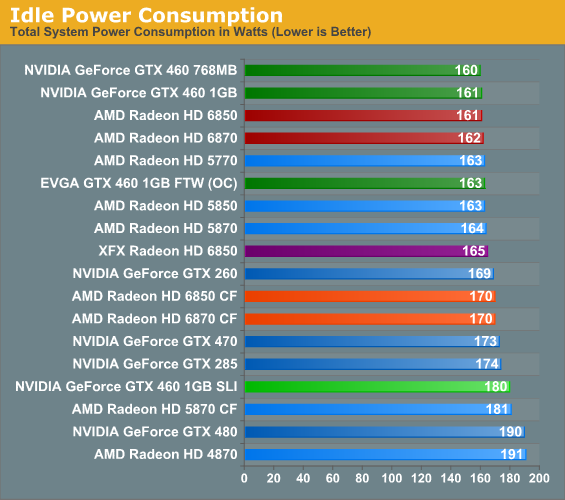
As always we start our look at power/temp/noise with our look at idle power. Because we use a 1200W PSU in our GPU test rig our PSU efficiency at idle is quite low, leading to the suppression of the actual difference between cards. But even with this kind of suppression it’s still possible to pick out what cards have a lower idle power draw, as the best cards will still result in a total system power draw that’s at least a couple of watts lower.
AMD’s official specs call for the 6800 series to have a lower idle power draw than the 5800 series, and while we can’t account for all 8 watts we do manage to shave a couple of watts off compared to our 5800 series cards. The Crossfire results are even more impressive, with the 6870CF drawing 11W less than the 5870CF.
Compared to the 6800 series the GeForce GTX 460 768MB does manage to hang on to top honor here for a single card by a watt, however in SLI our 1GB cards do worse than our 6800 series cards by 10W.
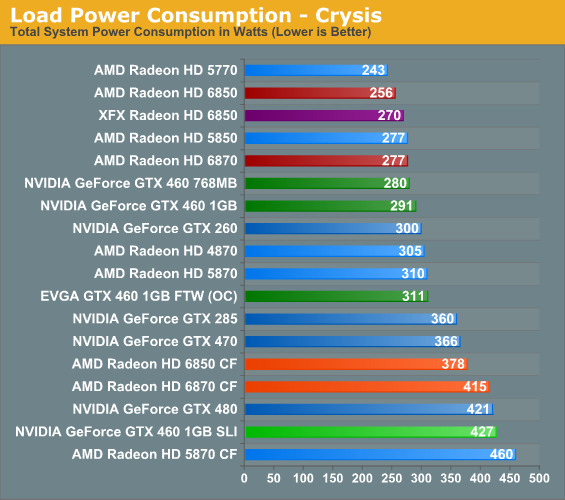
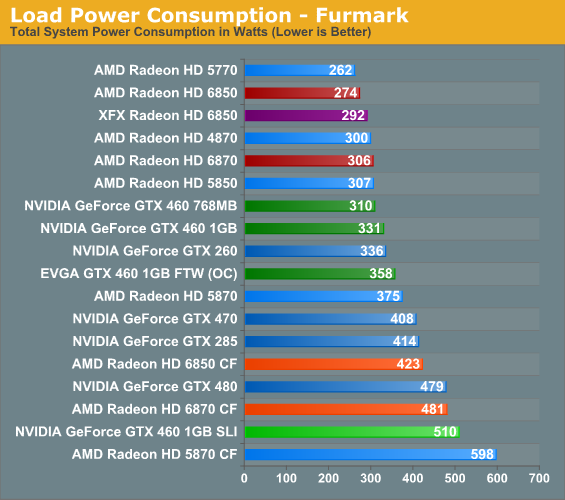
Looking at load power consumption it’s clear from the start that AMD’s efficiency gains are going to pay off here. On the latest iteration of our power consumption chart the 6850 underconsumes even the already conservative 5850 by 20W under Crysis and 25W under FurMark, showcasing how AMD was able to reduce their power consumption by a significant amount while giving up much less in the way of performance.
Compared to the 6800 series NVIDIA does notably worse here, with all of the GTX 460 cards pulling down more power than the 6870 and the GTX 470 being in a league of its own. While NVIDIA was competitive with Cypress on power, they’re not in a position to match Barts. They can deliver Barts-like performance (and then some), but they have to consume more power to do it.
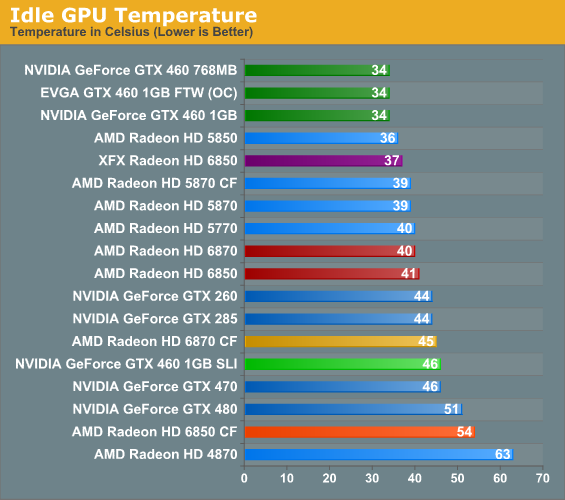
Up next is our look at GPU temperatures, starting with idle temps. As we mentioned in our GTX 460 review, NVIDIA ended up producing a very effective reference cooler for the GTX 460, utilizing an open-air design that by dissipating air inside and outside of the case is capable of reaching temperatures fully exhausting coolers can’t match. As a result all of the GTX 460 cards top our charts here.
Prior to the GTX 460 series this is a metric the 5850 always did well in, so we had expected a similar performance from the 6850, only to leave disappointed. What we’re ultimately looking at is a matter of the quality of the cooler: the 6850 may consume less power than the 5850 at idle, but it packs a weaker cooler overall, allowing it to approach these temperatures. For a gaming card such as the 6800 series idle temperatures are almost entirely superficial once we get below 50C, but even so this tells us something about the 6850 reference cooler.
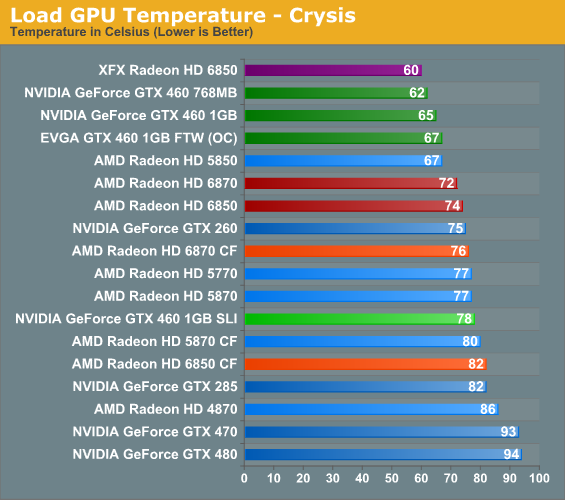
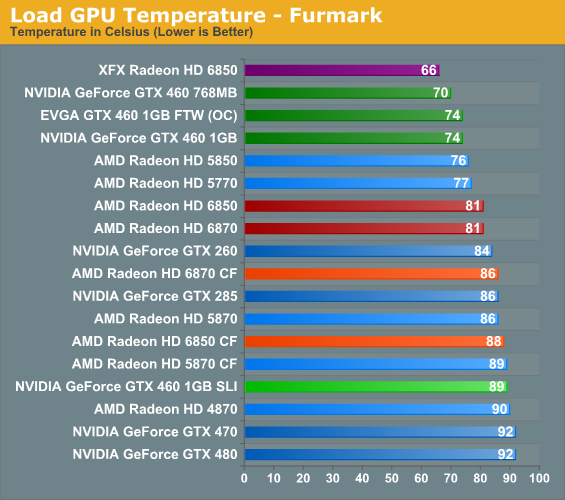
Thanks to the GTX 460’s open-air cooler, all of our GTX 460 cards top our temperature chart even with their higher power consumption. The trade-off is that all of these cards require a well-ventilated case, while the Radeon 5800 and 6800 series will tolerate much poorer cases so long as there’s enough ventilation for the card to pull in air in the first place.
As was the case with idle temperatures, the reference 6850 ends up doing worse than the 5850 here thanks to its less effective cooler; however the 6870 ends up doing better than both the 6850 and 5870 due to its more effective cooler and its lower power consumption compared to the 5870. While these cards can’t quite touch the GTX 460 series, we’re still looking at some of the coolest cards among our current benchmark suite.
Meanwhile our XFX 6850 ends up doing the best out of all of our cards here, however this will come at a cost of more noise. We'll touch on this more next week in our 6850 roundup.
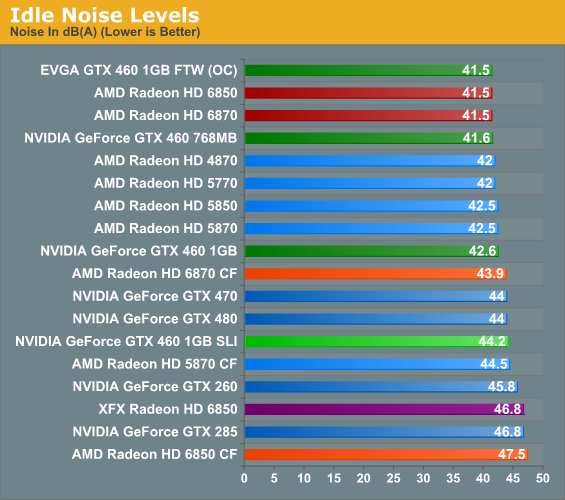
Last but not least is idle noise, which isn’t much of a story with modern cards. With the exception of the GTX 470/480, the latest GeForce and Radeon cards are both capable of running up against the noise floor of our testing environment.
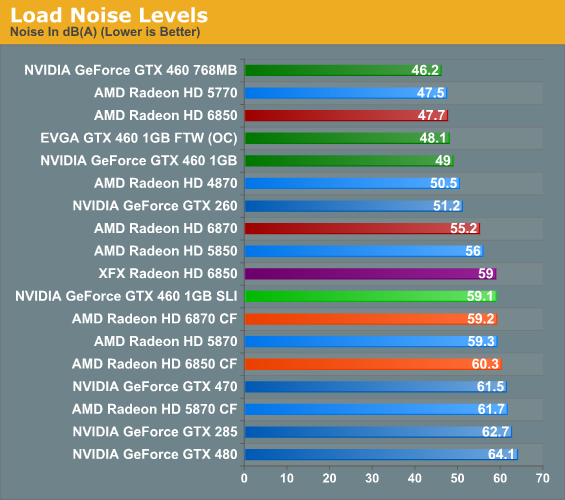
Under load we once again see an NVIDIA GTX 460 card top the chart thanks to its open-air design. This is followed very closely however by the Radeon 6850, which at 47.7dB is our third-quietest card and finally showing off the advantages of the tradeoffs AMD made with the reference cooler. The 6850 may not be as cool as the 5850, but it’s quite a bit quieter. As for the XFX card, this is where XFX has to pay the piper, as their 6850 card ends up being as loud as a 5870 in exchange for their lower temperatures.
Meanwhile the 6870 ends up being quite a bit louder than both the GTX 460 series and the 6850, coming in at 55.2dB. This is a definite leg-up compared to the 5870 and nicely cements the fact that the 6870 is intended to be the 5850’s replacement, but it means the GTX 460 series spoils the results here. Once custom-design vendor cards come out for the 6870, I suspect we’re going to see someone quickly sell a 6870 with a less aggressive cooler, which for the costs of higher temperatures would afford less noise.










197 Comments
View All Comments
Finally - Friday, October 22, 2010 - link
Did you have a look at the games market lately? Noticed all those shabby console ports? There is no progress because the graphics power of an XBOX or PS3 is exactly the same as it has been when they were introduced.Then again, who wants to play dumbed-down console games, made by illiterates for illiterates running on antique hardware which severely limits innovation in the graphics sector?
jimhsu - Friday, October 22, 2010 - link
"I know the 4890 is a pig (loud, noisy, power hungry) compared to the cards here"And hence your point. Essentially, major COMPUTER manufacturers (not just video card makers) simply are less concerned about maximum performance anymore -- for 95% of the population, what we have now is "good enough", and for the remaining 5%, getting more of the cheap stuff is also "good enough" (HPC builders, SLI/CrossFire, etc). Instead, people look at things like "is this quiet" (heat production, fans) or "what does this mean for my bottom line" (power consumption, replacability). The age of the monolithic "fast chip" is over.
Jamahl - Friday, October 22, 2010 - link
AMD naming the cards the 6800 series or Anandtech changing their policy of not reviewing overclocked cards.spigzone - Saturday, October 23, 2010 - link
AMD renaming their cards = more confusingAnandtech 'changing' their policy = more inexplicable.
softdrinkviking - Friday, October 22, 2010 - link
i join the throngs of disgruntled consumers that object to the new naming convention of the 6800 series.it's silly and stupid, and you should be ashamed of your collective AMD selves.
spigzone - Saturday, October 23, 2010 - link
I didn't like it either ... until I saw the release prices ...Then I didn't much care anymore.
gorg_graggel - Friday, October 22, 2010 - link
why the heck didn't they just call them 6850 and 6530? according to the numbers those are the the true internal competitors...that would also fit with the premise that a next-gen card with the same naming conventions is at least a bit faster...
the upcoming 6950 and 6970 cards could accordingly be named 6870 and 6890 respectively...
and the next 2-chip variant could have the 69xx namespace for itself as it clearly wouldn't be justified to append an x2 to it, due to the same reasons the 5000 dual-chip cards don't do this...
because of different chips? john doe doesn't know about such distinctions and just cares about performance (compared to older generations) when upgrading.
he's just confused why the 6870 is slower than a 5870 and the guy who knows more about the tech behind it is pissed, because he has to explain to him why the names are not analogous to performance and why it's not kept consistent at least for a few generations...
the explanations amd has given about this is not satisfying and gives me the impression that they deliberately want to confuse customers...however i can't think of a logical "why"...
jonup - Friday, October 22, 2010 - link
To answer your question, Because that makes too much sense!Donkey2008 - Friday, October 22, 2010 - link
I agree 100%. The new naming scheme is misleading and it seems like 6750 and 6770 would have been much more accurate IMO. From AMD releases over the last several years, the performance of nex-gen 2nd tier cards are ~ equal to the previous top tier cards. This is the first time AMD has strayed from their naming scheme in a long time and it has all the makings of a marketing dept telling the engineers what to call their cards.Like to pointed out, 95% of consumers (the ones who waddle into Best Buy and tell someone at the Geek Squad counter to "install a gaming card") won't know the difference. Most of these average consumers will believe that a 6870 is a much better card performance-wise then the previous generation 5870, so they will see the price and think it is a steal. AMD is playing the numbers game with uneducated consumers ("higher numbers are better, right?") and it is sort of disappointing IMO. I expect more from them as a psuedo-fanboy (I am a current of owner of a 4850 and (2) 4890)
I am still anxious to see what the 69xx has to offer, but some of the excitement of the entire 6xxx series launch has faded because of the new naming scheme. I just don't like marketing games and being played. Tech people are not only sharp, but HIGHLY biased and any deviation from outright perfection usually gets punished (i.e. Microsoft Vista, iPhone 4 antenna, Nvidia GT 250, etc etc). AMD should have known better.
gorg_graggel - Friday, October 22, 2010 - link
hmmm well, on second thought it could make more sense in the future as the new scheme reorganized the naming to fit more to the performance categories...if they would have been named 6750/6770 their would be riots, because amd dared to raise the prices in the midrange segment, as the author of the article already said i think, which would be even worse...
in the past amd changed strategies of how big and fast chips are a few times, but the naming didn't...they just didn't have single chips that deserved a name in the x900-range...
so now that the cayman chip is in the 300w size amd changed its sweet-spot only strategy to a more standard strategy again with low-end, midrange, performance and high-end cards and the new naming does fit perfectly here...at least i have this impression...
so it maybe confusing now, but depending on how future products turn out it will make more sense again...